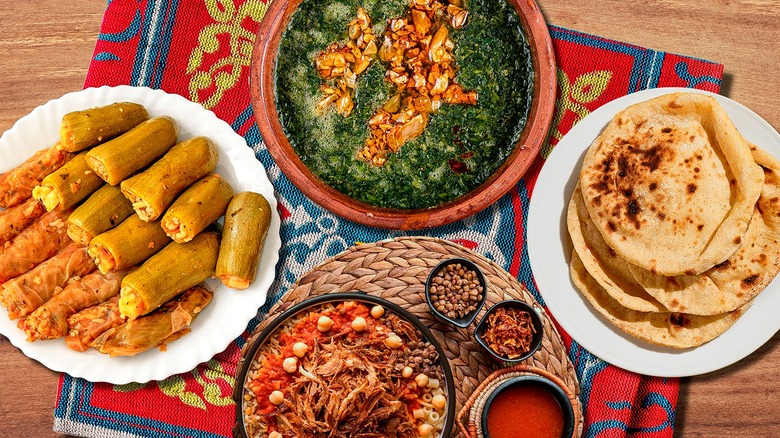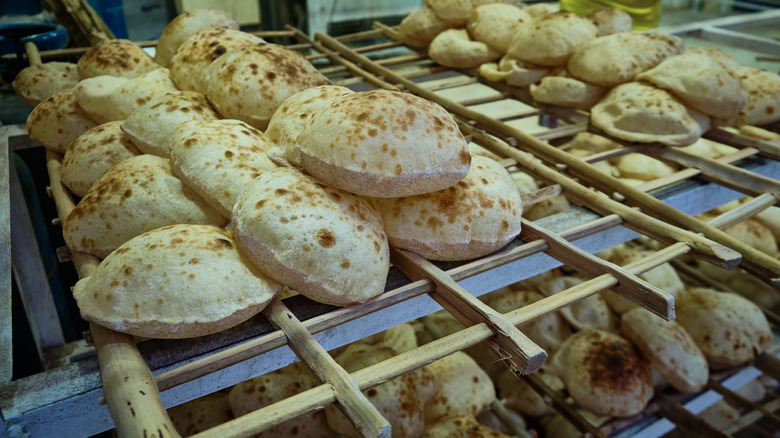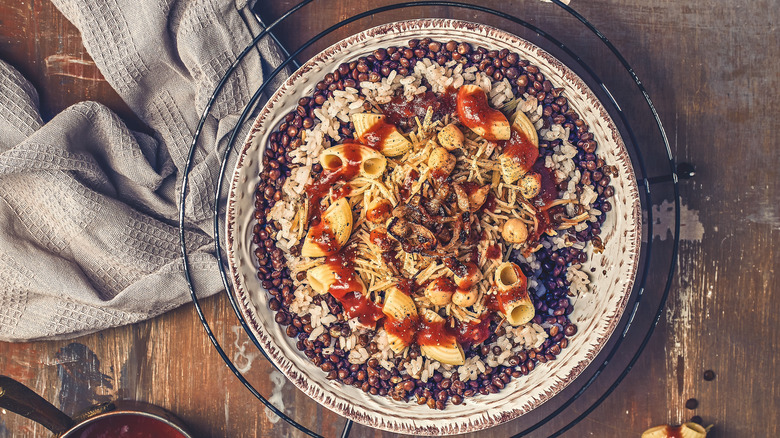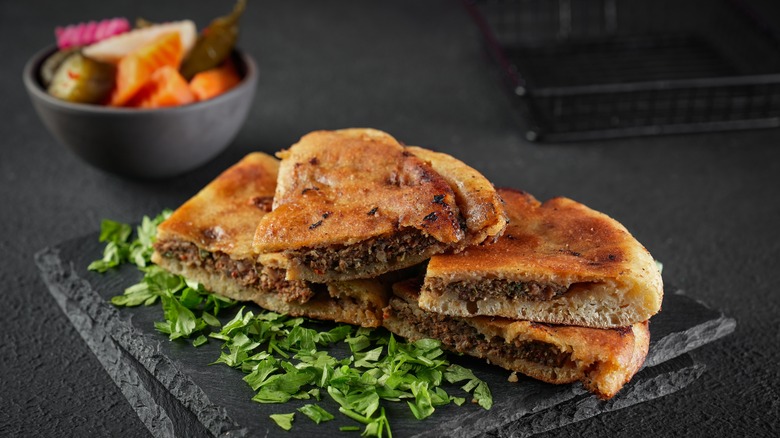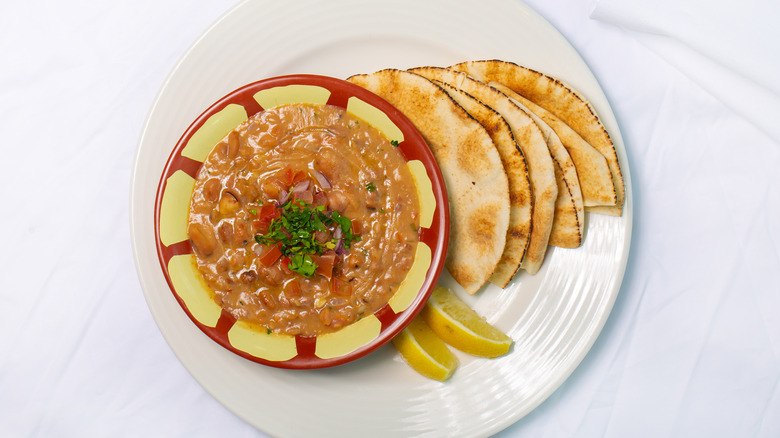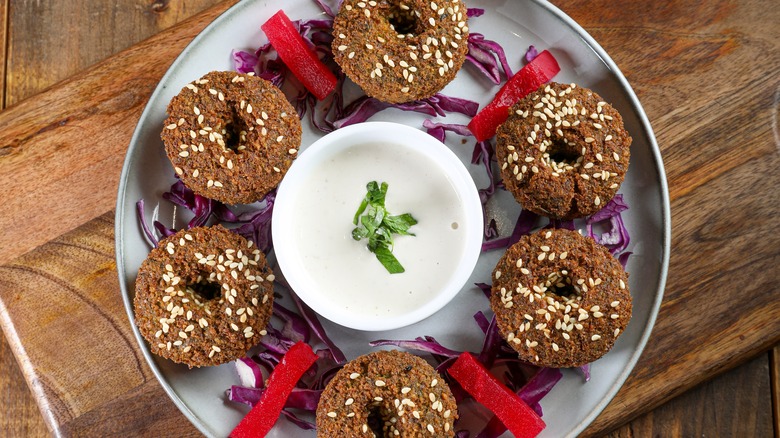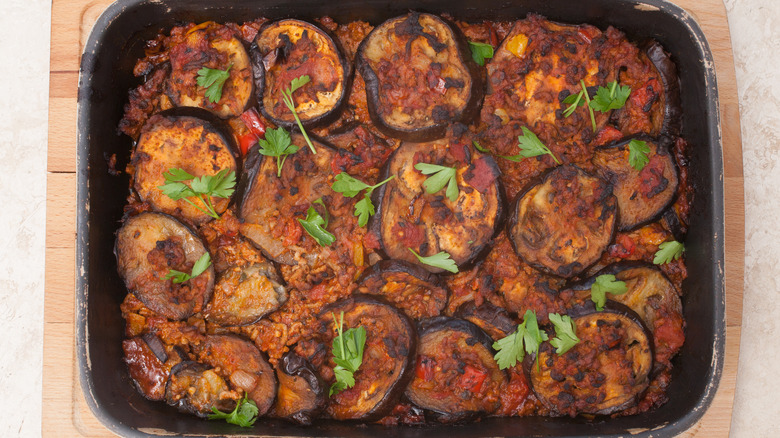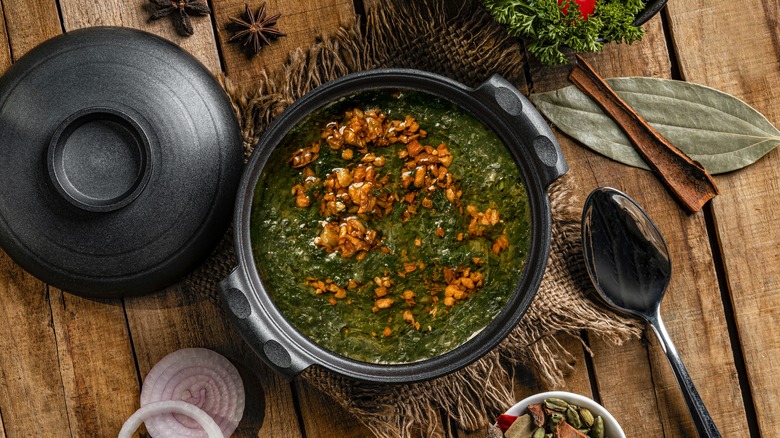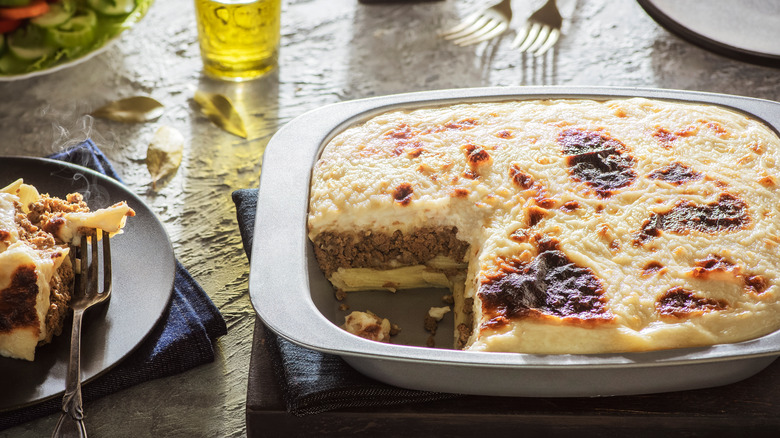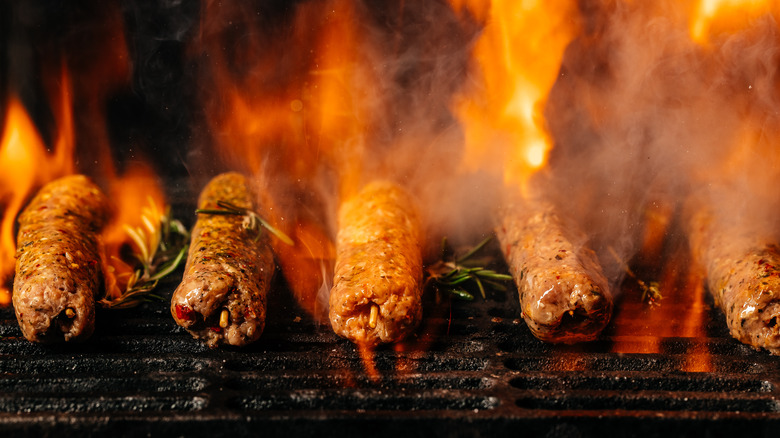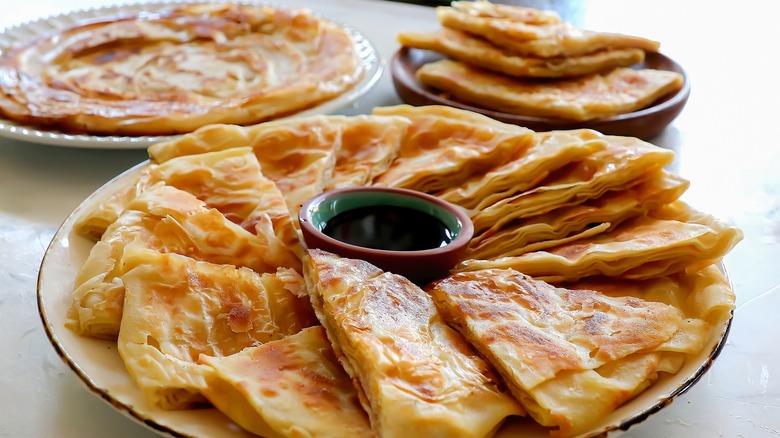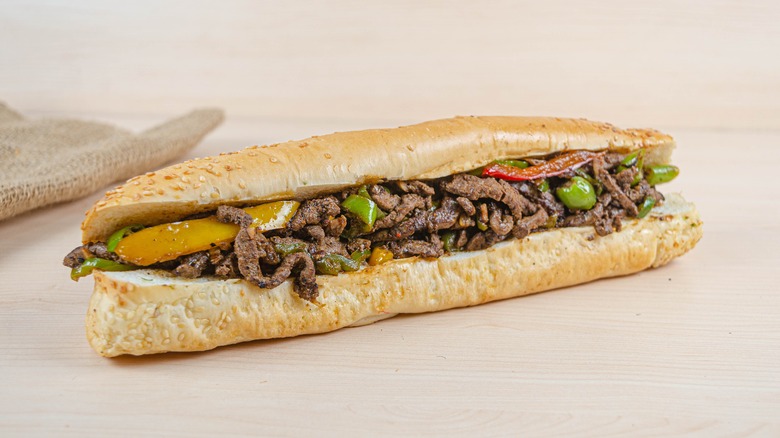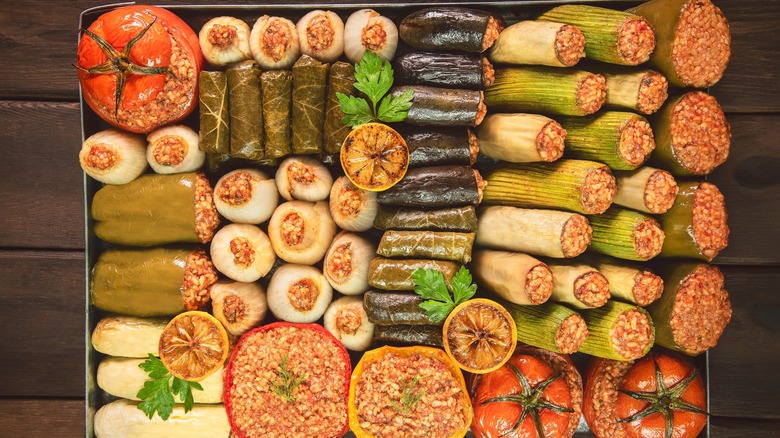12 Egyptian Dishes You Need To Try At Least Once
Egypt is known globally for many things: The Nile, the pyramids, the Valley of the Kings, and its endlessly fascinating ancient civilization. Cuisine may not be the first thing that comes to mind when people think of Egypt, perhaps because it's not as widespread as some of the other North African and Middle Eastern cuisines, like Moroccan or Lebanese. However, for many Egyptians like myself, food is up there as one of the things we love most about our culture. There are so many incredible dishes that mark Egyptian gatherings and meals, illuminating how hospitable, generous, and celebratory it is. As an Egyptian working in the food industry, I've heard from many who've traveled to Egypt for the ancient ruins and come back naming the food as one of their highlights.
Egyptian cuisine is also a haven for vegetarians and vegans, as many of the staples are completely meat and dairy-free. While there is a lot of overlap with other African and Middle Eastern cuisines, some dishes are uniquely Egyptian or have roots in Egypt that people don't know about. Right now, the cuisine is starting to have a moment worldwide, with Egyptian fast food chain Zooba opening locations in the U.S., Saudi Arabia, and Kuwait, and as koshari, one of Egypt's national dishes, has become popular due to the opening of several koshari take-outs in London. Whether it's making them at home, dining at an Egyptian restaurant, or actually going to Egypt, these are some of the dishes that you need to try at least once.
1. Aish baladi
The first thing you'll notice about Egyptian cuisine is that bread is always served on the table, and it's always freshly made aish baladi (meaning traditional bread). Aish baladi is round or oval, and it's a type of flatbread with a pocket, like pita bread but more commonly made with wholewheat flour. Many foods are eaten with bread or served inside it like shawarma, falafel, and even beef liver sandwiches.
Bread is by far one of the most important foods in Egypt. The fascinating ancient history of pita bread can be traced back over 10,000 years to prehistoric times, and it was a staple in ancient Egyptian civilization. In Egypt, bread is life, and it's even in the name: "aish," the Arabic word for life. It's considered daily food, and most Egyptians get fresh bread from their neighborhood bakery and don't rely on supermarkets for processed bread. Many households make their own bread, daily. Historically, there have always been communal neighborhood ovens where people take their dough to get it baked, especially in poorer communities where families may not have their own ovens.
2. Koshari
Koshari (also spelled kushari or koshary) is seen as Egypt's national dish and it's difficult to find an Egyptian who doesn't love it. Starting out as a working-class dish that was affordable for all, koshari is comprised of a mix of pasta, rice, lentils, tomato sauce, and the very important topping of fried onions. Yes, this dish contains both rice and pasta and is one of the most unique pasta dishes from around the world. It's believed to have its origins in the Indian rice and lentil dish, kitchari, which was supposedly brought to Egypt during the British colonial period. It's now a wildly popular street food that's loved by all classes.
Nowadays popular koshari fast food chains and street food trucks offer customizable koshari bowls with variations, including different meats, chickpeas, and all sorts of salads and sauces. However, the beauty of this dish is its simplicity and that it's a completely vegan meal, and celebrated as a meat-free dish. The secret to a good koshari is in the tomato sauce, which needs to be quite vinegary to lift this carb-heavy dish. It's where most of the flavor is coming from, so it's where you should put a lot of care. If you can perfect the tangy tomato sauce, the rest of the dish is a cinch to make.
3. Hawawshi
Hawawshi (pronounced ha-wow-shi) is a popular street food that hails from the coastal city of Alexandria. It's a mix between a flatbread pie and a grilled sandwich. Filled with a spiced and fatty ground beef mixture that has peppers, onions, and sometimes pine nuts, its flavor will surprise you with each bite. The fatty meat juices soak into the pastry, which is grilled until crisp on the outside, while still warm and soft inside. This comfort food on the go is found in many fast food stores in Egypt, and hawawshi carts fill the "corniche" (beach road) of Alexandria, making it a nostalgic beach time snack for many Alexandrian families.
It's also deceptively easy to make if you can't access one made by a professional. While people may prefer to make their dough from scratch, it's much simpler when using store-bought pita bread. Make the filling in a food processor to save time chopping, and you'll be able to put this together in under 20 minutes. Stuff your pita bread with the meat mixture, and cook these little pita pockets on the grill or in the oven. Great for kids and adults alike, it makes the perfect addition to your picnic basket or barbeque table.
4. Ful medames
Ful (pronounced "fool" and means "beans") or ful medames is another dish that competes for Egypt's number one national dish spot. "Medames" means buried, signifying how the dish used to be cooked in the ground using coal. Nowadays, however, it's cooked on the stovetop everywhere except in certain rural communities which still make authentic "ful medames." Ful is a dish that has defined Egyptian food for centuries and still occupies a large spot in modern Egyptian cuisine because of its simplicity and affordability, as well as being incredibly delicious.
This fava bean stew can be eaten at any meal but is most popular for breakfast. Many family breakfasts would not be complete without a pot of ful. Fava beans are slowly cooked until tender with cumin, tahini, olive oil, and lemon juice, with the option of adding tomatoes, parsley, onions, and more. Ful is sometimes served as is, or mashed into a paste, and eaten with aish baladi. You can often buy a freshly prepared, warm ful sandwich on the street in most neighborhoods. This vegan dish is a staple and some people eat it every day, making it the most eaten dish in Egypt. It's a dish you can't miss out on, so make sure to give it a try.
5. Ta'ameya or falafel
Falafel is a popular fried legume ball all over the Middle East, but many believe that it originated in Egypt. This is largely due to the Coptic Christian population in Egypt that has always done fasts from animal products for most of the year, including Lent, Advent, and many commemorations of saints throughout the year. Many believe that this is why Egypt's cuisine is generous in vegan foods. Falafel, or as it's known in Egypt, ta'ameya (although many Egyptians also use the name falafel and you won't be misunderstood if you do too), is one of the many tasty vegan dishes in Egyptian cuisine.
The real difference between ta'ameya and falafel is that falafel in the Levant is made with chickpeas, while in Egypt, ta'ameya is made with fava beans. Like ful, ta'ameya is another fava bean dish that's eaten at breakfast., and people will invite friends and neighbors over for a breakfast of "ful we (and) ta'ameya." Ta'ameya is fried until crispy on the outside and fluffy on the inside. It's usually bright green on the inside as the ta'ameya mixture is mixed with a large amount of fresh herbs, including dill, parsley, and coriander. It's often eaten in a sandwich form inside some aish baladi with tahini generously drizzled over and topped with a combination of salad and pickles. A ta'ameya sandwich makes for a flavor-packed, textural meal that's as easy on the pocket as it is on the tastebuds.
6. Mesaka'a
Mesaka'a or mesakaa is the Egyptian cousin to the Greek dish, moussaka. How moussaka varies around the world shows just how recipes are adapted in different regions. The Egyptian and Greek versions share many similarities, with the main ingredient being eggplant cooked until buttery soft in a layered casserole. These layers are baked in a tomato-based sauce which sometimes (but not always) includes ground meat. Where the two dishes differ is that the Greek version usually has a potato layer and a bechamel layer. In Egyptian mesaka'a, these layers aren't included and the dish is more of a celebration of eggplant as it's the main star, with little else.
Traditionally, people leave raw eggplant slices in the sun before cooking, covered with salt to draw out any bitterness and excess moisture. These slices are then washed off, dried, and fried in oil, before being layered with tomato sauce and placed to bake in an oven. Nowadays, different methods are employed as an alternative to frying eggplant, as they absorb oil like a sponge and can make the dish too heavy. People also pre-cook eggplant in the oven, air fryer, or even the microwave. Spice mixes differ from cook to cook, but the sauce is usually spiced with cinnamon, adding a pleasant warmth to the eggplant. It's served with rice, and if you're lucky enough to have leftovers, add it to some bread to make the most delicious eggplant sandwich.
7. Molokhia
Molokhia is a dish that hasn't made its way onto the international food scene yet, but it's considered one of the backbones of Egyptian cuisine. This green leafy soup is made with molokhia leaves, also known as jute leaves or jute mallow, that have been finely chopped and cooked in a chicken or rabbit broth. Rabbit has traditionally been a delicacy in Egypt and is usually the base for molokhia. Now, many people use chicken unless it's a special occasion because it's easier to access than rabbit.
Molokhia is seen as a health-promoting dish as jute leaves have anti-inflammatory benefits and are high in minerals like magnesium and calcium. As it's laborious to finely chop molokhia, it's very common to find it already minced at the supermarket, and many buy these packets for convenience. This healthy soup is then topped with a generous amount of fried chopped garlic and fresh coriander, making it a fragrant and flavor-packed soup. It's usually served with vermicelli rice, chicken or rabbit pieces, and even bread like aish baladi. Many children grow up eating molokhia, and it's a rite of passage to learn how to make little bread pockets called "boats" or "ears" to dip into the soup. Molokhia can be polarizing to people who aren't used to it, but we suggest you try it and make up your own mind.
8. Macarona bechamel
Macarona bel bechamel or macarona bechamel (meaning macaroni with bechamel sauce), is a baked pasta dish that Egyptians sometimes call Egyptian lasagna. It's quite different from lasagna, but it's a layered baked pasta with ground beef, topped with bechamel sauce. It's made with penne, and not macaroni as the name might suggest. However, "macarona" has become the "Arabized" word for all types of pasta in Egypt. It's considered one of the staple comfort foods and there's no dinner party or gathering that's complete without it. Luckily, there's always an aunty that brings one.
The most intimidating thing about this dish is the bechamel, but once you have all the tips you need for making béchamel sauce, this can become a weeknight staple that your family will love. What makes this dish special is that the bechamel is baked into an almost solid form rather than a saucy one, making it a stand-alone layer right at the top that's crucial to the success of an authentic macarona bechamel. You'll know it's right when the top of the bechamel is golden brown with some darker spots, resembling a slightly charred creme brulee.
9. Kofta and kebab
For meat eaters, kofta and kebab are the pinnacle of Egyptian grilled meats. They're often served together, but if you prefer one over the other you can order just kofta or just kebab. Kofta is a minced meat skewer that's been ground finely with a mixture of onions, herbs, and spices, making for an herbaceous taste. Kebab is cubed pieces of beef or lamb that have been marinaded in onion "juice" and seasonings. Both are cooked on skewers over flaming coals, giving them a wonderful smoky barbecue taste. Egyptian restaurants often grill kofta and kebab in an open kitchen so you'll see the smoke and flames rise as they're basted. The sign of a well-grilled skewer is that it has a light char on the outside while being moist and juicy on the inside.
These meats are often served with rice, or a mix of salads and aish baladi so that you can make your own meat sandwich. Kofta is traditionally drizzled with tahini, similar to ta'ameya, and a side of pickles adds the needed acidity to break through the fattiness. If you're cooking these at home, it can be tricky to not end up with dry, dense kofta. The key to perfect kofta is to choose a meat mixture with a high percentage of fat. This is the secret behind a juicy, soft kofta. The fat will melt and keep the meat well-basted throughout cooking.
10. Feteer meshaltet
Feteer meshaltet, also referred to as just feteer, is the flaky buttery pastry that everyone swoons over. It could be considered Egypt's version of a croissant, but it's much bigger, round, and flat, with layers of pastry that are often cut into pieces to be shared. It's slightly more decadent than a croissant, as it's usually made with ghee rather than butter, which has a more concentrated butter taste. The inner layers of pastry are softer than the outer crisp layers, making the texture just as pleasing as the taste.
The best thing about feteer is that it's neither sweet nor savory, and you can decide how you want to eat it. Traditionally you can order it with either salty cheese or honey and molasses for a sweet version. You can order it at most breakfast spots, but there are also some places that are solely feteer restaurants. Here you can order it will all sorts of fillings like meat and gooey cheese, or sweet fillings like nutella or custard. However you have it, a hot cup of black tea is the perfect accompaniment.
11. Kebda Eskandarani (Alexandrian liver)
Kebda is the Arabic word for liver, which in Egypt is a popular street food prepared in the Eskandarani — or Alexandrian — way, the city where it comes from. Alexandria, being a port city that has historically been a cosmopolitan hub in Egypt, has some of the most distinct regional cuisines in Egypt. However, while kebda eskandarani belongs to Alexandrian cuisine, it can be found all over Egypt.
Usually prepared with beef liver, it's cut into very thin pieces, marinated in cumin and garlic, and then drenched in lemon juice when cooked. Some prefer to eat it with hot chiles. The thinness of the meat and the way it's cut helps keep it tender, while it's cooked in scalding oil to give it an almost charred outside. Sold in hot sandwiches in food trucks and carts, it's another cheap and tasty meal that you can find on the street. Even if you're not a fan of eating liver, you should try it at least once, because the way it's marinaded and cooked might convert you.
12. Mahshi (stuffed vegetables or vine leaves)
Mahshi (pronounced with a throaty "h" sound, like mahh-shi) is the general Arabic name for anything stuffed, which in Egypt is quite a lot of foods. Most mahshi consists of vegetables that have been hollowed out and then filled with an incredibly tasty stuffing made from par-cooked rice, spices, tomatoes, and fresh, fragrant herbs. Ground meat is sometimes included in stuffing but not always. Then, these stuffed vegetables, including zucchini, eggplant, tomatoes, onions, cabbage, peppers, and potatoes, are slow-cooked in a broth, until soft, but still holding together.
It's a labor of love, but although many catering services prepare impressive plates of mashi, many people still go to the trouble of making it at home. One of the popular mahshi dishes is rolled up vine leaves, known as warak enab in Arabic-speaking countries, and dolmades in Greece. These little fingers are beloved across the region, and it's no different in Egypt. Whatever choice of mahshi you choose, you can't go wrong, plus, you can often order an assorted plate at an Egyptian restaurant, meaning you don't have to choose.
